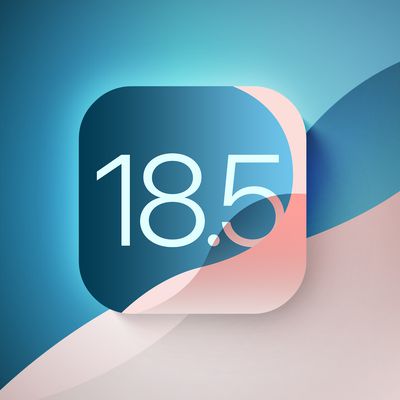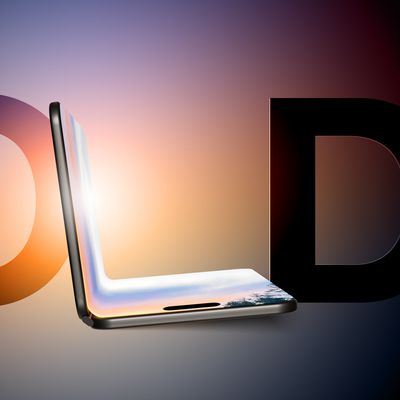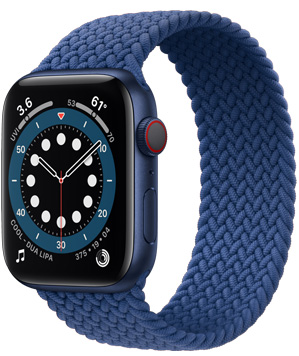In September 2020, Apple updated its popular Apple Watch lineup, introducing two new models; the Apple Watch Series 6 and the Apple Watch SE.
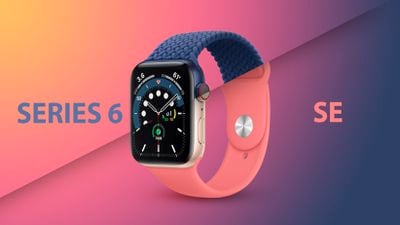
The Apple Watch Series 6 offers a number of compelling updates on 2019's Series 5, offering a new S6 processor, a U1 ultra-wideband chip, and blood oxygen monitoring, for a price starting at $399. At the same time, Apple introduced an entirely new model of Apple Watch; Apple Watch SE. This new model offers many of the Apple Watch features that have made the device so popular over the years, but at a much more competitive price starting at $279.
The Apple Watch Series 6 has since been discontinued by Apple and replaced with the Apple Watch Series 7, but the Series 6 is still available from some third-party retailers for prices much lower than the original $399 starting price.
As these two models share many key features, including design, water resistance, and an optical heart sensor, it may not be immediately obvious which model is better for you. Is it worth purchasing the cheaper model with fewer features? Our guide answers the question of how to decide which of these two Apple Watch models is best for you.
Comparing the Apple Watch Series 6 and the Apple Watch SE
Most of the features of these two models of Apple Watch are the exactly same. Apple lists these identical features of the two models:
Similarities
- 44mm or 40mm case size
- Retina LTPO OLED display, with brightness of 1,000 nits
- GPS and GPS + Cellular models
- 64‑bit dual-core processor
- W3 wireless chip
- Digital Crown with haptic feedback
- Optical heart sensor
- High and low heart rate, and irregular heart rhythm notifications
- International emergency calling, emergency SOS, and Fall Detection
- Noise monitoring
- Water resistance up to 50 meters; "swimproof"
- Wi‑Fi and Bluetooth 5.0
- Support for Family Setup (GPS + Cellular models)
- Compass and always-on altimeter
- 32GB storage capacity
- 18-hour "all-day" battery life
Apple's breakdown shows that the two models share an overwhelming majority of features. Even so, there are a small number of meaningful differences between the Apple Watch Series 6 and the Apple Watch SE that are worth highlighting, such as ECG and blood oxygen monitoring.
Differences
- Always-On Retina display
- S6 SiP with 64‑bit dual-core processor
- U1 ultra-wideband chip
- Blood Oxygen app
- ECG app
- Blood oxygen sensor; electrical heart sensor and second-generation optical heart sensor
- Improved battery life for certain workouts, faster charging
- New Colors: Blue and (PRODUCT)RED
- Retina display
- S5 SiP with 64‑bit dual-core processor
- Optical heart sensor only
Read on for a closer look at each of these aspects, and see what exactly both of the latest Apple Watch models have to offer.
Displays
Both the Apple Watch Series 6 and Apple Watch SE come with a Retina LTPO OLED display, with a brightness of 1,000 nits. The key difference, however, is that the Series 6 has an always-on display. This means that even when you lower your wrist, the display remains on, so you can always see your watch face without having to raise your wrist correctly.
The Apple Watch Series 6 always-on display is up to two and a half times brighter than the Apple Watch Series 5 outdoors when the user's wrist is down, making it much easier to see a watch face in bright sunlight. When their wrist is down, users can also now access Notification Center and Control Center, tap on complications, and swipe to change faces without having to wake their watch screen.
The Apple Watch SE does not have an always-on display, meaning that users will have to raise their wrist or tap the display to see their watch face.
Other than this feature, the high-resolution Retina displays themselves are the same between the two models. Unless you feel that you particularly need to see your watch face at all times without raising your wrist, the Apple Watch SE's display will be more than adequate for your needs.

S6 vs. S5 Processor
Both processors in the Apple Watch Series 6 and Apple Watch SE are 64‑bit dual-core chips. The newer S6 processors are based on the A13 Bionic in the iPhone 11, and are up to 20 percent faster than the previous S5 processors. Apple says that this allows apps to launch 20 percent faster, while maintaining the same "all-day" 18-hour battery life.
The Apple Watch SE inherits the Apple Watch Series 5's S5 dual-core processor, which still "delivers incredibly fast performance," according to Apple. The S5 is up to two times faster than Apple Watch Series 3.
The S5 was already a capable processor when it premiered in the Apple Watch Series 5, and the S6 simply offers a more refined chip. The minor performance improvements of the S6 chip do not seem to be enough to justify getting the Apple Watch Series 6 over the Apple Watch SE unless you absolutely need faster app launch speeds. For the vast majority of users, the Apple Watch SE's processor will be suitably fast and efficient.
U1 Ultra-Wideband Chip
Only the Apple Watch Series 6 contains the U1 ultra-wideband chip. Apple says that the U1 on Apple Watch will "enable short-range wireless location to support new experiences, such as next-generation digital car keys," but it is as yet unclear what else the chip may offer.
The distance between two devices that support ultra-wideband can be measured precisely by calculating the time that it takes for a radio wave to pass between the two devices, with much more accuracy than Bluetooth LE and Wi-Fi.
Although Apple has increasingly been implementing the chip on its new devices, it has yet to unlock substantial new features on the Apple Watch. The U1's functionality on Apple Watch Series 6 may well be expanded in the future.
Since the U1 chip currently has such few use cases, it is not worth getting the Apple Watch Series 6 simply because of it. Nevertheless, if you plan on keeping your Apple Watch for many years, the U1 chip will likely make it a much more future-proof model, due to the high chance that more functionality will come to it in the coming years.
Health Monitoring
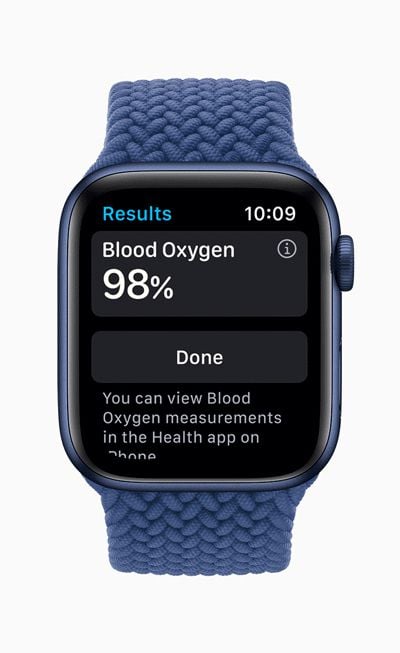 Apple Watch Series 6 offers blood oxygen monitoring; a brand new health monitoring feature never seen before on the Apple Watch. The feature measures the oxygen saturation of the user's blood, so they can better understand their overall fitness and wellbeing. Oxygen saturation, also known as SpO2, represents the percentage of oxygen being carried by red blood cells from the lungs to the rest of the body, and indicates how well this oxygenated blood is being delivered throughout the body.
Apple Watch Series 6 offers blood oxygen monitoring; a brand new health monitoring feature never seen before on the Apple Watch. The feature measures the oxygen saturation of the user's blood, so they can better understand their overall fitness and wellbeing. Oxygen saturation, also known as SpO2, represents the percentage of oxygen being carried by red blood cells from the lungs to the rest of the body, and indicates how well this oxygenated blood is being delivered throughout the body.
The Apple Watch Series 6 has a blood oxygen sensor on its rear with an array of four clusters of green, red, and infrared LEDs. They measure light reflected back from blood, and using an advanced custom algorithm, can determine blood oxygen saturation between 70 and 100 percent.
On-demand measurements can be taken using the Blood Oxygen app, and periodic background measurements are also taken, including during sleep. All data is visible in the Health app, and the user is able to track trends over time to see how their blood oxygen level changes.
Moreover, the Apple Watch Series 6 contains the electrical heart sensor from previous models that is used to take electrocardiograms, or ECGs. The Apple Watch Series 6 has electrodes built into the Digital Crown and an electrical heart rate sensor on the rear. With the ECG app, users touch the Digital Crown and after 30 seconds, receive a heart rhythm classification. It can classify if the heart is beating in a normal pattern or whether there are signs of Atrial Fibrillation (AFib), a heart condition that may lead to major health complications. All recordings, their associated classifications, and any noted symptoms are stored in the Health app in a PDF that can be shared with physicians.
The Apple Watch SE does not have a blood oxygen or electrical heart sensor to monitor either of these health statistics. However, the Apple Watch SE is not without the ability to record any health data.
The Apple Watch SE has an optical heart sensor to monitor heart rate, and can give notifications about high and low heart rate, and as well as irregular heart rhythm. The lower-cost model can also still perform emergency SOS, Fall Detection, and noise monitoring, just like the Apple Watch Series 6.
The additional health monitoring features of the Apple Watch Series 6 are the main appeal of the more expensive model. If you believe that ECG and blood oxygen monitoring will be important to you, you should consider the Apple Watch Series 6. If these advanced health features are less of a priority for you, the Apple Watch SE still has some insightful health monitoring capabilities.
Battery
Both Apple Watch models retain what Apple calls an "all-day" battery life of around 18 hours.
Apple Watch Series 6, however, offers faster charging, completing a full charge in under one and a half hours, and improved battery life for tracking certain workouts, such as indoor and outdoor runs. The Series 6 has also been optimized to be theoretically unaffected by its always-on display.
Since the battery life of both models is virtually the same, it is probably not worth favoring the Series 6 simply on the basis of faster charging and slightly improved battery usage during particular activities. The Series 6's battery and charging enhancements instead remain an important indication of how the device offers a range of small but meaningful improvements over the Apple Watch SE.
Design
The Apple Watch Series 6 and Apple Watch SE share the same basic design, but differ when it comes to materials and color options.
The Apple Watch Series 6 is available in aluminum, stainless steel, or titanium, while the Apple Watch SE is only available in aluminum. Apple Watches with stainless steel or titanium also use a sapphire crystal screen, whereas the aluminum models use Ion-X strengthened glass.
The Apple Watch Series 6 in aluminum is available in Silver, Space Gray, Gold, Blue, or (PRODUCT)RED. In stainless steel, it is available in Silver, Graphite, or Gold, and in titanium, it is available in Titanium or Space Black. The Apple Watch SE is only available in Silver, Space Gray, or Gold.
If you prefer stainless steel, titanium, or a Blue, (PRODUCT)RED, Graphite, Titanium, or Space Black finish, you should get the Apple Watch Series 6 as it is the only model to offer these materials and color options. If, however, you are content with a light-weight aluminum casing, and basic Silver, Space Gray, or Gold finishes, then the Apple Watch SE will be sufficient.
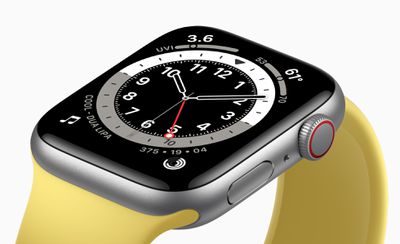
Other Apple Watch Options
Apple also offers the Apple Watch Series 3 for $199. This older model offers substantially fewer features and has a smaller screen. The Apple Watch Series 3 is still a capable device, with 8GB of storage, water resistance up to 50 meters, an altimeter, Emergency SOS, and an optical heart sensor. Functionally, it is more pared back than the Apple Watch SE, being thicker with larger bezels.
The Apple Watch Series 3 is really only intended for those who want an Apple Watch at the lowest possible price, but it will certainly be the least future-proof model. Given that the Apple Watch Series 3 is a much older model, if you can afford an Apple Watch Series 6 or Apple Watch SE, you should definitely prefer those newer options.
Final Thoughts
The Apple Watch Series 6 is very much an improvement over the previous Series 5 model, offering new features such as blood oxygen monitoring, the S6 and U1 chips, and an always-on altimeter. With its always-on display, advanced health monitoring features, and range of colors and finishes, the Apple Watch Series 6 will be the model of choice for those that more out of their wearable. If you are particularly interested in health tracking, or simply like a particular casing and color combination, the Apple Watch Series 6 will be the best model for you.
Alternately, if you are on a budget and are not particularly attracted to the additional features of the Series 6, the Apple Watch SE is a very compelling option. The Apple Watch SE is the go-to model for many Apple Watch customers, particularly those that are new to the device.
The Apple Watch SE will likely be the most popular model of the two, so for most potential customers, this will be the default choice. As it shares so many features with the Apple Watch Series 6, you should only choose the more expensive model if you value additional features such as the always-on display or advanced health monitoring and can justify the added cost.







